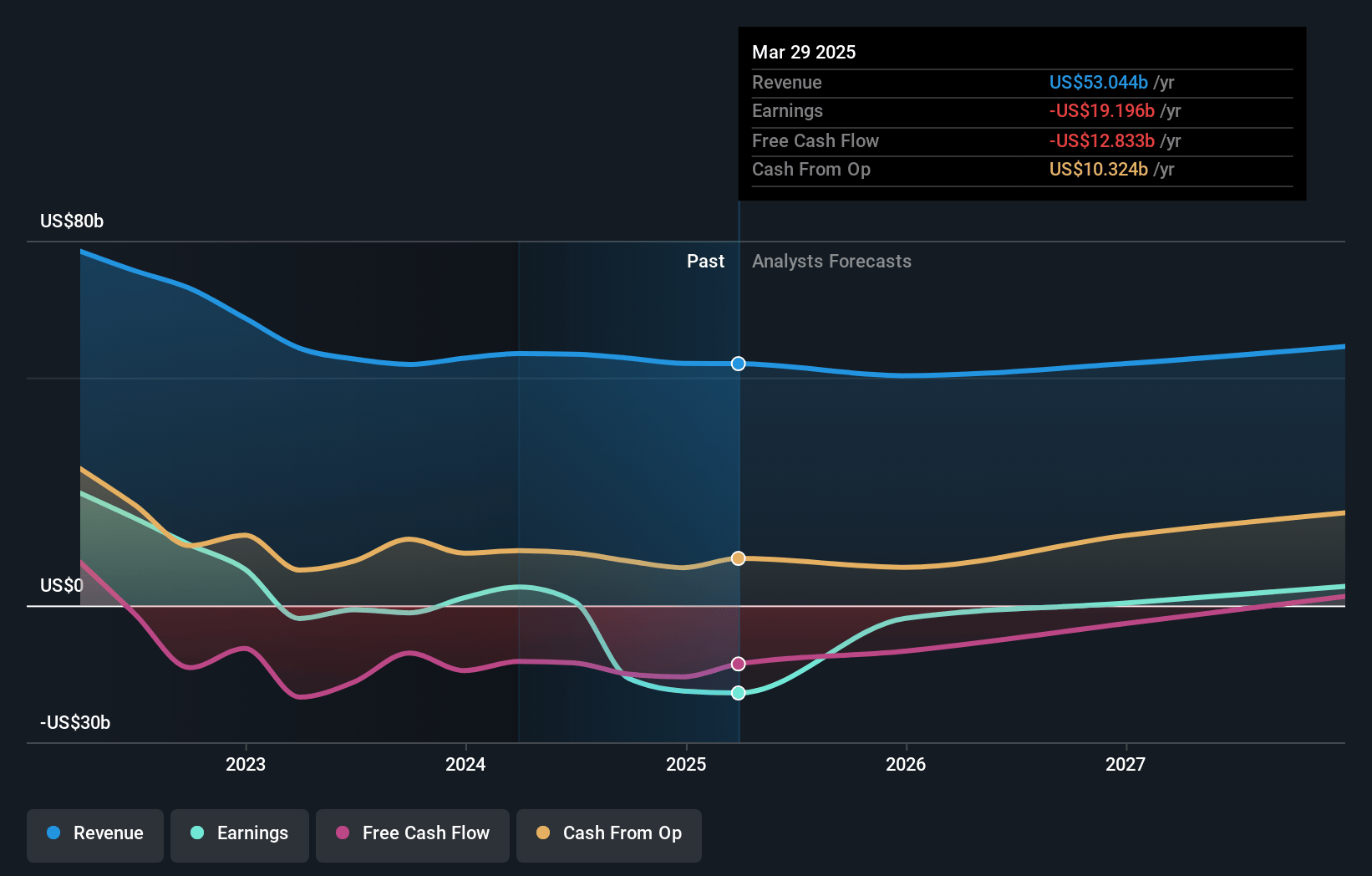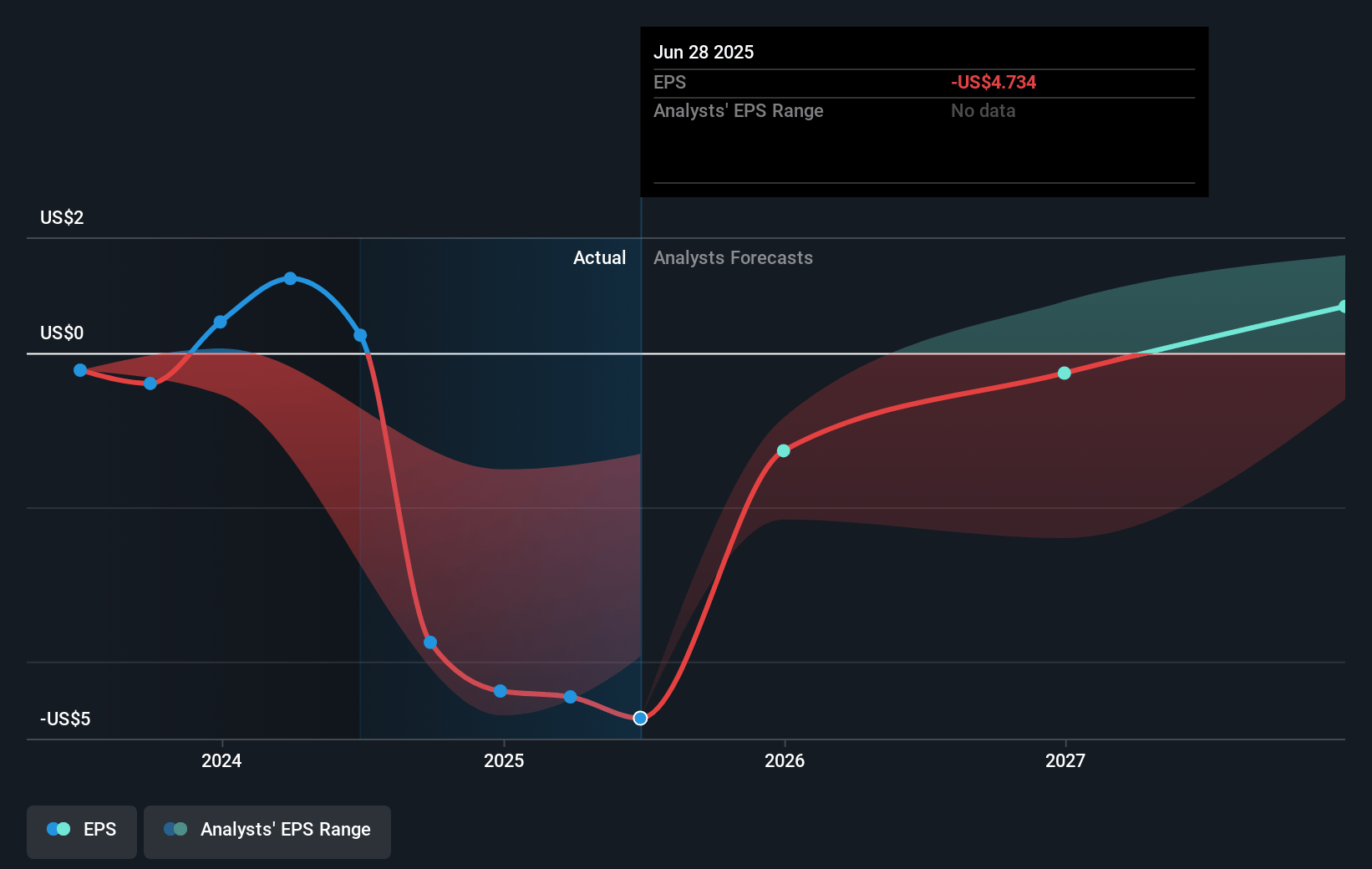Key Takeaways
- Competitive pressures in AI and data centers may necessitate aggressive pricing, affecting revenue growth and margins.
- Intel Foundry's negative margins and operational changes pose profitability challenges, with execution risks potentially impacting financial performance and market share stability.
- Strategic investments in AI and next-gen products aim to drive revenue growth, improve margins, and stabilize market share through enhanced performance and competitive offerings.
Catalysts
About Intel- Designs, develops, manufactures, markets, and sells computing and related products and services worldwide.
- The competitive pressures Intel faces, particularly in the AI PC and data center markets, may dampen revenue growth and hurt margins as the company may have to engage in aggressive pricing strategies to sustain or regain market share.
- Intel Foundry's negative gross margins and significant operating losses highlight potential concerns in delivering profitability, which can impact earnings if improvement isn't achieved as planned by 2027.
- Execution risks are present given the complexity of simultaneously advancing products like Granite Rapids and Panther Lake, which may pressure financial performance if delays or issues arise, impacting revenue and margins.
- Internal operational and structural changes aimed at long-term improvements could bring near-term challenges, affecting Intel's earnings as it seeks to stabilize market share with enhanced but potentially costlier processes.
- The macroeconomic environment and anticipated tariffs could weigh on Intel's revenue and lead to a cautious outlook for gross margin improvement, affecting overall profitability expectations.
Intel Future Earnings and Revenue Growth
Assumptions
How have these above catalysts been quantified?- This narrative explores a more pessimistic perspective on Intel compared to the consensus, based on a Fair Value that aligns with the bearish cohort of analysts.
- The bearish analysts are assuming Intel's revenue will grow by 1.6% annually over the next 3 years.
- The bearish analysts assume that profit margins will increase from -35.3% today to 4.3% in 3 years time.
- The bearish analysts expect earnings to reach $2.4 billion (and earnings per share of $0.37) by about April 2028, up from $-18.8 billion today. The analysts are largely in agreement about this estimate.
- In order for the above numbers to justify the price target of the more bearish analyst cohort, the company would need to trade at a PE ratio of 52.1x on those 2028 earnings, up from -5.0x today. This future PE is greater than the current PE for the US Semiconductor industry at 20.3x.
- Analysts expect the number of shares outstanding to grow by 1.71% per year for the next 3 years.
- To value all of this in today's terms, we will use a discount rate of 11.16%, as per the Simply Wall St company report.
Intel Future Earnings Per Share Growth
Risks
What could happen that would invalidate this narrative?- Intel's leadership committed to improving performance and execution, which can positively impact revenue, gross margin, and EPS if successful.
- The company's position as a market leader in AI PC CPUs and plans to ship more than 100 million systems by the end of 2025 may drive revenue growth and strengthen margins.
- Investments in next-generation products like Panther Lake and Nova Lake are expected to enhance performance across the PC stack, potentially improving costs and profit margins.
- Progress in Intel's traditional and AI data centers, including the competitive Granite Rapids and Clearwater Forest products and leveraging the x86 ecosystem, could stabilize market share and support revenue.
- Intel Foundry's advancements, including customer engagement, technology offerings with Intel 18A, and collaboration with industry partners, may improve its profitability and contribute positively to net margins.
Valuation
How have all the factors above been brought together to estimate a fair value?- The assumed bearish price target for Intel is $19.6, which represents one standard deviation below the consensus price target of $22.9. This valuation is based on what can be assumed as the expectations of Intel's future earnings growth, profit margins and other risk factors from analysts on the more bearish end of the spectrum.
- However, there is a degree of disagreement amongst analysts, with the most bullish reporting a price target of $31.0, and the most bearish reporting a price target of just $17.7.
- In order for you to agree with the bearish analysts, you'd need to believe that by 2028, revenues will be $55.6 billion, earnings will come to $2.4 billion, and it would be trading on a PE ratio of 52.1x, assuming you use a discount rate of 11.2%.
- Given the current share price of $21.53, the bearish analyst price target of $19.6 is 9.8% lower. The relatively low difference between the current share price and the analyst bearish price target indicates that they believe on average, the company is fairly priced.
- We always encourage you to reach your own conclusions though. So sense check these analyst numbers against your own assumptions and expectations based on your understanding of the business and what you believe is probable.
How well do narratives help inform your perspective?
Disclaimer
AnalystLowTarget is an employee of Simply Wall St, but has written this narrative in their capacity as an individual investor. AnalystLowTarget holds no position in NasdaqGS:INTC. Simply Wall St has no position in the company(s) mentioned. Simply Wall St may provide the securities issuer or related entities with website advertising services for a fee, on an arm's length basis. These relationships have no impact on the way we conduct our business, the content we host, or how our content is served to users. This narrative is general in nature and explores scenarios and estimates created by the author. The narrative does not reflect the opinions of Simply Wall St, and the views expressed are the opinion of the author alone, acting on their own behalf. These scenarios are not indicative of the company's future performance and are exploratory in the ideas they cover. The fair value estimate's are estimations only, and does not constitute a recommendation to buy or sell any stock, and they do not take account of your objectives, or your financial situation. Note that the author's analysis may not factor in the latest price-sensitive company announcements or qualitative material.








